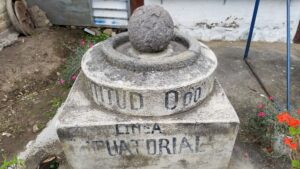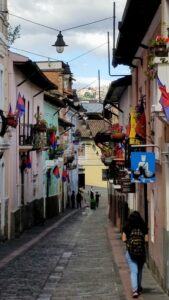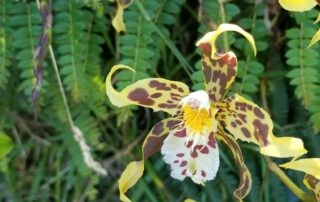The Basics:
Ecuador is in north western South America, straddling the equator. The Quichua spelling is Ikwadur. Bordered by Columbia to the north and Peru to the south the country includes the Galapagos Islands. It is not a large country, 270k sq miles: about the size of Finland, larger than Uruguay – there are 16.5 million people living in the country.
Ecuador has a long history of indigenous peoples, pre-dating the Incas, but like much of Central America was conquered by the Spanish in the 16th century. Despite the Spanish colonization the majority of the people are of indigenous heritage, many communities still practice ancient cultural traditions and 18 languages are recognized including Quichua and Shuar.
Famous for its bio-diversity, it has more diversity per square kilometer than any other nation. More than 1,600 bird species and 6,000 species of butterflies have been documented; add in the 17,000 species of plants (including 3000 orchid species) and more than 130 types of amphibians and it’s easy to understand how Ecuador became the first country to recognize the rights of nature in its constititution.
There are 4 distinct regions including the islands.
The Galapagos – 972 km off the coast, in the Pacific ocean, are the world famous 19 islands. With no natural predators the wildlife is unafraid of visitors. Renowned as an area that showcases evolution it is the most visited part of Ecuador. The islands are names for the giant turtles that live there, other endemic creatures include penguins, reef and hammerhead sharks, iguanas, sea lions, lizards and blue and red footed boobies. To help protect the islands you can only visit using specialized travel agents
The Coast – approximately 1000 km the coast is famous for its unspoiled beaches, quaint fishing villages, archeological sites, mangroves, estuaries and wetlands. The area is also the most fertile and home to large banana plantations.
The Highlands – The Andes are the spine of Ecuador, dotted with volcanoes, glaciers, Inca ruins, waterfalls and picturesque villages. Home to the world’s highest volcano, Chimborazo – 20.5k ft, the beautiful Cotopaxi and enormous Cayambe, Ecuador has 12 peaks over 16,000 feet.. Cloud forests laden with massive ferns and dotted with spectacular orchids can be reached on foot or horse – you might see a rare horned frog .The views are mesmerizing, valleys and rivers, mountains and meadows. All around the landscape is lush: forests of unusual tress, potatoes and corn growing in rich soils, fat and happy cows munching on verdant grass. Hummingbirds flit amongst flowers, Condors can be seen soaring above, other birds can be heard and seen in the different vegetation.
The Amazon – in the north east of the country is the jungle. A schizophrenic area as much of it is preserved and national parks, inhabited by the Amazon Amerindian Tribes living traditionally, it is also home to Ecuador’s petroleum industry which has not been good to the area and caused extensive environmental damage.
Quito, the capital – sits at about 9,300 feet above sea level, in the north of the country.
Guayaquil – the largest city – is near the coast, on a river estuary.
Currency :
US dollar – Credit cards are widely accepted in the cities, but you’ll need small dollar bills in the countryside and at the markets.
Language:
Spanish is spoken by most people, though many speak Quicha and other indigenous languages.
Religion:
Primarily Roman Catholic 80% with Protestant 10%.
Time Zone:
is 2 hours ahead of California – the same as US Central Time.



Visiting
Getting there: Situated in the north west of South America most people fly. The main airports are in Quito and Guayaquil. The big American carriers as well as Copa, Aeromexico, Avianca, KLM, Iberia and LATAM fly to Quito. Copa, LATAM, Avianca, KLM, Air Europa fly to Guayaquil.
Destination ( 1 week +) ? = 
Absolutely you will need more than 1 week to see all that Ecuador has to offer.
- The mountains:
- The city of Quito is a Unesco Heritage city for its Spanish Colonial buildings. Many are showing signs of city wear and tear, but some remain quite lovely. Walk around, visit the Mercado, the gothic Basilica, The Cathedral, Government Palace, San Francisco Museum. Walk down the pretty La Ronda – small shops and some restaurants. Hike or cab to El Panecillo for great views of the city.
- Head north to Otovalo market, situated in a valley between Imbabua and Cotacachi volcanoes. Visit Cotacachi, near Otovalo, has high quality leather goods – saddles, to bags to boots. Cuicocha lake – a crate lake that you can hike around. On the way back stop at the Mitad del Mundo which markets the two hemispheres.
- See condors, hawks, eagles and owls at the Condo Park.
- Avenue of the Volcanoes – you can explore by car, horse or mountain bike. The communities are fascinating the scenery is breathtaking.
- Southern Andes – warmer, drier and lower elevations lead to sparse vistas, ecological preserves and Inca ruins, plus a pretty city, Cuenca.
- See “Extraordinary Ecuador” to learn more
-
- Home to 9 natural reserves enabling visitors to see a vast array of incredible waterfalls, jungles and rivers. You can fly from Quito to Coca, Lago Agrio and Macas. Tena and Puto are about 4 hours from Quito by car.
- Galapagos and the Coast
- You can drive to the coast from Quito – apparently it has amazing bird watching! Manabe province is known for its fishing – sea bass is plentiful, and Wahoo can be caught from fishing boats that go out to sea. Santa Elena province is a surfers destination. Guayaquil, the largest Ecuadorian city, is the main port. The Malecon is a 1/5 mils waterfront with restaurants, shopping and entertainment. Las Penas is a picturesque neighborhood. The historical park is a 19 acre park of mangroves,local flora and wildlife and even some examples of urban architecture.
- The Galapagos – so much has been written about these Islands I’ll leave it to people who visited to update you.
What to eat and drink
The food in Ecuador is diverse and delicious.
- Soups – almost every lunch/dinner will include a soup, often potato based. Locro is the most famous – definitely try iy.
- Fish and shell fish– tuna, bass, shrimp, langostines. Trout is delicious and often available in the highlands.
- Ceviche – different to Peru and Chile, s the fish is often cooked rather than marinated in lime, well worth trying.
- Meats – Cuy (Guinea pig) chicken, pork and beef
- Fruits – there are so many: mango, 3 types of passion fruit, carambola, banana, babaco, gooseberries, cherimoya and more
- Plantains – fried as chips, mashed, sautéed are best.
- Empanadas – meat and cheese
- Chocolate – considered by connoisseurs to be the best in the world. Try delicious chocolates with interesting flavors, Andean Rose and passion fruit are good starts.
- Aji – the local salsa
- Pan de yucca – a bread made from Yuca and cheese – served warm they are delicious.
- Encebollado – a seafood stew, usually tuna and yucca
- Cuy = Guinea pig. Usually toasted, it’s a bit gamey,but it’s a staple and provides good protein with limited impact on the planet, so don’t be squeamish.
What to drink:
- Canelazo – a rum based drink flavored with cinnamon, limes, orange, sugar, cloves and water.
- Horchata – a herbal tea
- Colada Morada – made from black or purple corn and fruits.
- Naranjilla, passion fruit or other fresh fruit juices. Remember, only drink it if you see the source of added water – ie a bottle.
- , Beer aka Pilsner
- Coffee
- Hot chocolate
What to bring home:
- Roses are exported around the world and some can be taken home.
- Superb cacao/chocolate (recent DNA discoveries indicate cacao may have originated in Ecuador)
- Coffee
- Scarves, gloves, blankets from the market. Be realistic if the prices are really low they don’t have a high percentage of alpaca, but they can still be lovely.
- Alpaca and vicuna clothing
- “Panama” Hats, actually originated in Ecuador. The good ones are still made in Ecuador, though expensive. There are versions sold in the market that mostly seem to be made in Columbia
- Jewelry and pottery- there are some superb artisans.
- Tagua nut jewelry and carvings- it looks like ivory but comes from the Ecuadorian Ivory palm.
What you should know before you go:
- The weather can be changeable: in the highlands – all four seasons in 1 day. Dress in layers, carry something rain proof to wear and pack warm clothes for the evening. The Amazon has a lot of insects, leave your shorts at home and consider taking rubber boots.
- The altitude can take some getting used to. If you plan to hike, bike or ride a horse, get to Quito a couple of days early. Some people choose to take Diamox, others rely on ginger tea etc. Just give your body a chance to adjust. Remember, your resting heart rate usually rises by 1 point for every 1k feet elevation gain – i.e. it’s working hard.
- Because of the elevations, if you have tubes of creams etc. squeeze them a little at home, otherwise when you take the cap off everything will squirt out.
- The people of Ecuador are really friendly, be gracious to them
- Expect to bargain at the markets, it’s not a poor country but don’t be cheap, a lot of work goes in to making the crafts that you see.
- Prices are lower than the US but not super cheap, Ecuadorians have a middle class standard of living in the cities.
- While the tap water is fine for local people, your system will not be used to it. Drink bottled water.



Extraordinary Ecuador
What a brilliant decision it was on a rainy Sunday morning to decide to visit Ecuador. To be honest, the country wasn’t on my radar despite my extensive travels, but a friend [...]


